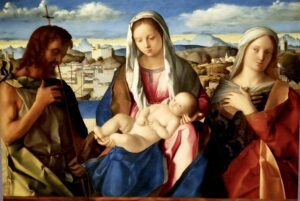 Oil painting developed in Northern Europe early in the 15th c. and Italian painters of the next generation quickly adopted the medium to their own unique vocabulary. Antonello di Messina is generally credited with the introduction of oil painting to Italy and more specifically, to Venice. Artists such as Giovanni Bellini, as well as Leonardo further expanded the expressive potential of the medium. The processes that these artists developed consequently influenced the whole history of Western Art.
Oil painting developed in Northern Europe early in the 15th c. and Italian painters of the next generation quickly adopted the medium to their own unique vocabulary. Antonello di Messina is generally credited with the introduction of oil painting to Italy and more specifically, to Venice. Artists such as Giovanni Bellini, as well as Leonardo further expanded the expressive potential of the medium. The processes that these artists developed consequently influenced the whole history of Western Art.
This workshop will follow their methods. Working from reproductions participants will use materials of the time, prepared by hand in a traditional way. Beginning on a wooden panel, prepared with rabbit skin glue and chalk gesso, participants will transfer their perforated drawings with charcoal and a pounce, then develop a wash drawing with genuine sepia ink, followed by an imprimatura – a colored “veil” - that establishes a tonality and a very useful neutral color. From here, oil paint ground in class will be used to develop the underpainting. Afterwards, rich glazes of transparent colors made primarily from pigments produced in in our Pigments and Paint Workshop.
Throughout the workshop, participants will be housed in the remarkably well-preserved Umbrian hill town of Monte Castello di Vibio. Your workshop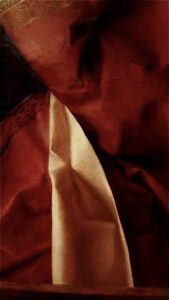
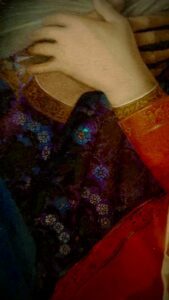
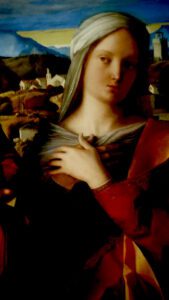 package is all-inclusive, providing welcome and departure services and airport transfer from the Rome Fiumicino,Leonardo Da Vinci Airport (FCO). Aboard our comfortable private bus, single occupancy accommodations with shared bath (a wide range of upgrades with private bath are available), 3 meals per day Monday-Thursday, Prosecco brunch and dinner on Saturday and Sunday (no meals are served on Friday, our excursion day. Your workshop includes an excursion to Perugia. Of course, throughout your stay, 24/7 access to facilities and 24/7 bi-lingual support are provided.
package is all-inclusive, providing welcome and departure services and airport transfer from the Rome Fiumicino,Leonardo Da Vinci Airport (FCO). Aboard our comfortable private bus, single occupancy accommodations with shared bath (a wide range of upgrades with private bath are available), 3 meals per day Monday-Thursday, Prosecco brunch and dinner on Saturday and Sunday (no meals are served on Friday, our excursion day. Your workshop includes an excursion to Perugia. Of course, throughout your stay, 24/7 access to facilities and 24/7 bi-lingual support are provided.
Price of the workshop includes all materials needed to produce the painting described above, except brushes, which will be available for sale at ICA in Italy. While it is unlikely that the painting will be completed in the timeframe allowed by the workshop, our goal is to give participants a sufficient understanding of the Northern Renaissance process in order to complete the painting at home. As part of the course fee, participants will be issued a unique case for the painting that allows the painting itself to be folded into a carry-on luggage-sized parcel even if not fully dry.
In a world leaning towards the virtual and on-line, there is a need for artists to come together to share their experiences of using tangible materials. The knowledge of the body and use of ‘haptic’ skills are being lost and now is the time for reconnecting with these materials in order to re connect with ourselves, each other and with the environment we live in.
Ceramic sculptor Sharon Griffin aims to use her work to express how we can connect with ourselves and each other using clay as a tool of experiencing the body. Within this short course, Sharon will demonstrate her knowledge of working with clay as an expressive material, one which will release the innate stories of the maker, acting as a mirror to the artist.
Sharon explains that...’ the clay acts as a mirror to our own experiences. Learning how to listen to the clay helps us have a truer understanding of ourselves... we can tell all of our secrets to the clay. It is our truest friend!'
You will learn to let go of preconceived ideas of what a sculpture ‘should’ be through a series of fast and furious making techniques. Gestural mark-making using found clays, slips and oxides taken from the local landscape will enable you to truly find your freedom and capture expression within the clay material.
Using a combination of found objects and resources such as images, reference photos and books, you will have fun exploring and making a series of playful clay faces and bodies. These playful experiments will provide more in-depth opportunities to explore surfaces and patterns within a unique piece or series of works made within the course.
Sharon will guide you in your personal journey of studying the human form and face to create a unique sculpture, one which explores 3 D formal elements such as weight, shape, form, composition, and texture; all of which will help you tell a story.
We will visit Rome and explore the work of the ancient Greeks, drawing inspiration from the ancients and stories told through artefacts and sculptures. Sketching, photographing, and journaling will help inform your own ideas, not just within the course, but in your future developments as an artist if you so desire.
At the end of the course, you will have the opportunity to take home a unique hand-built sculpture which is individual to you. It may need to be sent out at a later date and can be negotiated as your work develops. You will have learned about the processes of clay, where to dig it, sieve it and use it to create your own piece of work- expressing your own unique story.
Drawing, sketches, and experiments within clay are used to capture feeling and express emotion, captivating your audience with a shared human experience.
Through taking part in this course, Sharon Griffin hopes that you will come away from it with a renewed sense of connectivity, one which connects you to history, the people around you and the landscape you live in.
Aims: How to capture expression and emotion using clay within figurative sculpture
Objectives: At the end of the course you will
Be inspired by and understand how shape, form and composition can help to tell a story
Techniques we will cover:
Participants in the workshop will be housed in the remarkably well-preserved Umbrian hill town of Monte Castello di Vibio. Your workshop package is all-inclusive, providing welcome and departure services and airport transfer from the Rome Fiumicino, Leonardo Da Vinci Airport (FCO). Aboard our comfortable private bus, single occupancy accommodations with shared bath (a wide range of upgrades with private bath are available), 3 meals per day Monday-Thursday, Prosecco brunch and dinner on Saturday and Sunday (no meals are served on Friday, our excursion day. Your workshop includes one excursion per week and many additional options are available on weekends for an additional fee. Of course, 24/7 access to facilities and 24/7 bi-lingual support are provided.
This course is suitable for beginners, intermediate and advanced levels but some knowledge of clay is beneficial. Please do feel free to bring sketchbooks and previous drawings to work from but this is not a necessity. For more details, please contact Sharon Griffin at the ICA
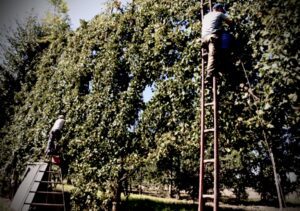 When we think of Italian wine regions, most often, we think about Tuscany and Piedmont but instead, this boot-shaped country has so much varied landscapes and oenological culture to discover. One of the least-known regions but with outstanding wines is Campania, the region of Naples where the tradition of gastronomy is supremely important.
When we think of Italian wine regions, most often, we think about Tuscany and Piedmont but instead, this boot-shaped country has so much varied landscapes and oenological culture to discover. One of the least-known regions but with outstanding wines is Campania, the region of Naples where the tradition of gastronomy is supremely important.
It’s a volcanic territory where the mighty Mount Vesuvius reigns but little do we know that there’s a super volcano sleeping quietly very close to it, underneath the ground, sandwiching Naples in between. The locals are actually living on top of the underground volcano! Referred to as a super volcano, Campi Flegrei or Phlegraean Fields in English (also known as burning fields), is comprised of 24 craters and edifices, many of which are underwater in Pozzouli Bay. Rocks, pozzolans and lapilli born from fire are scattered about which make the soil for viticulture extremely special. The wines are born with great personalities, imprinted with deep expressions of minerality, marked salinity and bright acidity influenced by the composition of the soil where they are planted. The white variety Falanghina and the red variety Piedirosso express excellently in this territory.
Then there are the 10 to 20-meter high old vines of Asprinio d’Aversa. These are vines climbing around tall poplars or elm trees which act as guardians. On their full vegetative cycle, you find yourself in-between tall green walls of grapevines with treetops poking out like at regular intervals. The wines produced from Aprinio d’Aversa has its own peculiarity with its crispy acidity and refreshingly dry character giving out aromas of white jasmine and fresh herbs.
Campania has lot of indigenous grapes that thrive well in its characteristic soils. Coda di Volpe, Coda di Pecora, Casavecchia, Falanghina, Biancolella, Greco, Fiano, Aglianico, Piedirosso, and more. These are excellent wines to drink and when they are aged, they evolve deeper with beautiful complexity, but they are not as diffused outside the region as we would want them to be. This is a great reason to see and taste Campania on your next visit!
Participants will be housed in the remarkably well-preserved Umbrian hill town of Monte Castello di Vibio. Your workshop package is all-inclusive, providing welcome and departure services and airport transfer from the Rome Fiumicino, Leonardo Da Vinci Airport (FCO). Aboard our comfortable private bus, single occupancy accommodations with shared bath (a wide range of upgrades with private bath are available), 3 meals per day Monday-Thursday, Prosecco brunch and dinner on Saturday and Sunday (no meals are served on Friday, our excursion day. Your workshop includes one excursion per week and many additional options are available on weekends for an additional fee. Of course, 24/7 access to facilities and 24/7 bi-lingual support are provided.
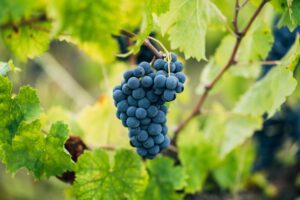 Autochthonous refers to a variety of grape from a specific terroir. In other words, a particular type of grape adapted to a specific soil and geography, as well as to tradition. Italy is one of the countries with the most autochthonous grapes in the world - and there are 545 registered varieties for making wine! Each one has its distinguishing quality and story. The Italian producers have started to revive these vines, some of which were almost extinct, and produce wines from them, just like the old times.
Autochthonous refers to a variety of grape from a specific terroir. In other words, a particular type of grape adapted to a specific soil and geography, as well as to tradition. Italy is one of the countries with the most autochthonous grapes in the world - and there are 545 registered varieties for making wine! Each one has its distinguishing quality and story. The Italian producers have started to revive these vines, some of which were almost extinct, and produce wines from them, just like the old times.
In this workshop, we will learn about some of these grapes, and their traditions – we will taste the wines, and meet the producers who make them. Printouts will be handed to help facilitate learning during lessons, wine will be tasted and there will be visits to wineries. Let’s dive into the wine world of Italy and see and taste why this country is so special!
Additionally, our workshop dates coincide with the annual Cantine Aperte festival, which is one of the most important wine events of the year! At the festival, the seasons new wines are unveiled and vineyards open their doors to all who are eager to taste the new vintage. It is the good fortune of this workshop that the event falls of the first day of our activities – and we will attend the event! It is an amazing celebration and will be a great way to kick off the workshop.
Throughout the week-long experience, participants will be housed in the remarkably well-preserved Umbrian hill town of Monte Castello di Vibio. The workshop package is all-inclusive, providing welcome and departure services and airport transfer from the Rome Fiumicino, Leonardo daVinci Airport (FCO). Aboard our comfortable private bus, single occupancy accommodations with spectacular views, 3 meals per day Monday-Thursday, Prosecco brunch and dinner on Saturday.
The workshop includes daily tastings and winery visits as well as lunch at a Michelin-recommended restaurant, Il Frantoio, in Assisi and other meals at noteworthy vineyards. Finally, our “off-campus” meals will include a dinner at the renowned Torre a Cona vineyard, where we will be treated to a tasting of their wines and an extraordinary 6-course dinner!
Of course, throughout your stay, 24/7 access to facilities and 24/7 bi-lingual support are provided.
Those who have time might also consider the adding the additional 4-day tour: Little-known Wines of Campania, June 4 – 7, which will commence at the end of this workshop.
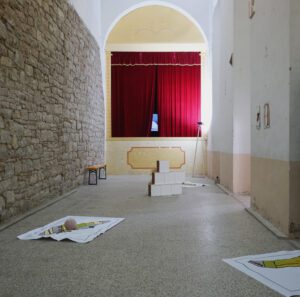 Living in the Play: nido residency, brings together an international consortium of artists to Monte Castello di Vibio, Italy, for a two-week artist residency that culminates in an exhibition of artworks and corresponding catalog.
Living in the Play: nido residency, brings together an international consortium of artists to Monte Castello di Vibio, Italy, for a two-week artist residency that culminates in an exhibition of artworks and corresponding catalog.
During the residency, our goal individually and collectively is to explore the social historical landscape, use of land resources, and the hidden histories of Monte Castello di Vibio and the surrounding region. This will inform and guide our conversations and contribute to the making practices of each artist amongst Living in the Play: nido.
This residency is in partnership with The Poor Farm Experiment in rural Wisconsin, USA, which has hosted Living In the Play since 2018. We are invested in creating spaces that uplift and connect fellow artists. Our goal is to gather artists through intentional actions that foster community. With a focus on inviting multi-generational and diverse pools of artists, we aim to offer art practitioners ways of engaging their practice with a focused depth of ideas around site, play, and community.
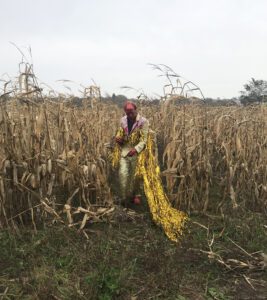 Participants will be housed in the remarkably well-preserved Umbrian hill town of Monte Castello di Vibio. Your workshop package is all-inclusive, providing welcome and departure services and airport transfer from the Rome Fiumicino, Leonardo Da Vinci Airport (FCO). Aboard our comfortable private bus, single occupancy accommodations with shared bath (a wide range of upgrades with private bath are available), 3 meals per day Monday-Thursday, Prosecco brunch and dinner on Saturday and Sunday (no meals are served on Friday, our excursion day. Your workshop includes one excursion per week and many additional options are available on weekends for an additional fee. Of course, 24/7 access to facilities and 24/7 bi-lingual support are provided.
Participants will be housed in the remarkably well-preserved Umbrian hill town of Monte Castello di Vibio. Your workshop package is all-inclusive, providing welcome and departure services and airport transfer from the Rome Fiumicino, Leonardo Da Vinci Airport (FCO). Aboard our comfortable private bus, single occupancy accommodations with shared bath (a wide range of upgrades with private bath are available), 3 meals per day Monday-Thursday, Prosecco brunch and dinner on Saturday and Sunday (no meals are served on Friday, our excursion day. Your workshop includes one excursion per week and many additional options are available on weekends for an additional fee. Of course, 24/7 access to facilities and 24/7 bi-lingual support are provided.
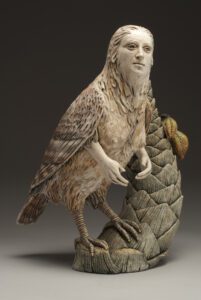 Unlock your imagination and develop coil-building and figure modeling skills in this two week human and animal hybrid ceramic sculpture workshop. Much of ancient Italian art is rich in mythological creatures and transformation that continue to speak to us, often on a visceral level. During this course, we’ll delve into the stories behind some of these beings, and create contemporary interpretations and invent new amalgamations that possess compelling personal narratives.
Unlock your imagination and develop coil-building and figure modeling skills in this two week human and animal hybrid ceramic sculpture workshop. Much of ancient Italian art is rich in mythological creatures and transformation that continue to speak to us, often on a visceral level. During this course, we’ll delve into the stories behind some of these beings, and create contemporary interpretations and invent new amalgamations that possess compelling personal narratives.
Through live demonstrations, slide presentations, and time lapsed videos, Adrian will impart a wealth of technical information based on 40 years of working with clay. Human and animal anatomy will be covered, with special attention to heads and faces. We will create medium size pieces, approx. 18” tall; the techniques covered will be useful for building large scale sculpture in the future. This includes sectioning, internal supports and the use of a base and rod for tall sculptures. In addition, we’ll make small sprig molds for surface texture and embellishment. Presentations on contemporary ceramic sculpture, as well as mythology will also be shown as time allows. Each Friday we’ll venture out of the studio to nearby sites, cities and museums for a full-immersion experience.
*Participants are encouraged to take good documenting photos of the process of building their piece and the final sculpture. Arrangements can be made to have work fired after the workshop. Packing and shipping will be at participants expense.
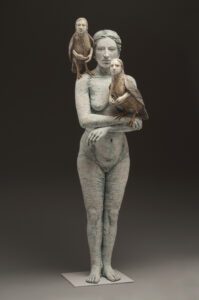 Participants will be housed in the remarkably well-preserved Umbrian hill town of Monte Castello di Vibio. Your workshop package is all-inclusive, providing welcome and departure services and airport transfer from the Rome Fiumicino, Leonardo Da Vinci Airport (FCO). Aboard our comfortable private bus, single occupancy accommodations with shared bath (a wide range of upgrades with private bath are available), 3 meals per day Monday-Thursday, Prosecco brunch and dinner on Saturday and Sunday (no meals are served on Friday, our excursion day. Your workshop includes one excursion per week and many additional options are available on weekends for an additional fee. Of course, 24/7 access to facilities and 24/7 bi-lingual support are provided.
Participants will be housed in the remarkably well-preserved Umbrian hill town of Monte Castello di Vibio. Your workshop package is all-inclusive, providing welcome and departure services and airport transfer from the Rome Fiumicino, Leonardo Da Vinci Airport (FCO). Aboard our comfortable private bus, single occupancy accommodations with shared bath (a wide range of upgrades with private bath are available), 3 meals per day Monday-Thursday, Prosecco brunch and dinner on Saturday and Sunday (no meals are served on Friday, our excursion day. Your workshop includes one excursion per week and many additional options are available on weekends for an additional fee. Of course, 24/7 access to facilities and 24/7 bi-lingual support are provided.
 A hands-on workshop on producing painting and drawing materials according to historical methods. The intensive, week-long workshop is ideal for painters interested in gaining greater familiarity with their materials, academics and teachers interested in curricular development, art historians, and people interested in developing a deeper understanding of traditional works.
A hands-on workshop on producing painting and drawing materials according to historical methods. The intensive, week-long workshop is ideal for painters interested in gaining greater familiarity with their materials, academics and teachers interested in curricular development, art historians, and people interested in developing a deeper understanding of traditional works.
Born in 1360, painter Cennino d’Andrea Cennini, left a remarkable legacy, beyond that of his surviving works.
A student, of a student, of Giotto, Cennino left of us a remarkable and intimate record of the life and working processes of a painter in his time. His book is called, il Libro del’Arte, simply, “The Book of Art.” It provides insights into the training of the artists of his time, as well as that of the next generations of artists in Italy. Incredibly, this included some of the greatest figures in the history of Western painting: Masaccio, Fra Angelico, Leonardo, Botticelli, Michelangelo, and Raphael among others. To the reader of today, Cennini’s text provides the remarkable opportunity to participate in this legacy.
On a practical level, Cennini’s book is also a very useful guide to the production of pigments, paints, painting surfaces, and other materials of the medieval and Renaissance artist. In this however, it also reveals something larger than that of a recipe book. It speaks to a very special connection between artists and the materials they choose. Often, that connection resulted from artists making their materials themselves, by hand. Indeed, Cennini refers lovingly to the rare, almost spiritual beauty of, ultramarine blue to the easy, sensual qualities of a charcoal black as well as to their sometimes, tempestuous personalities of materials like, dragon’s blood!
What is revealed is a unique connection to the materials of the artist, in which all elements have significance. As translator, Daniel Thompson describes, “A very choice black was, and still is, made from peach stones; and almond shells were sometimes charred to produce another sort. To the outsider all these blacks would seem very much alike; indeed, they would probably be quite indistinguishable. But a painter of the medieval kind becomes familiar with the little quirks of personality in his pigments, and is affected by small subtleties which it is hopeless to try to define, subtleties not so much of color as of working quality, how the pigment feels, how it mixes, whether it tends to settle out of a color mixture, or stays nicely in suspension, and little things like that.” These “little things” can indeed have big effect to the artist who remains sensitive to the qualities of their materials, creating a bond that becomes a language of its own.
We will use Cennini’s book as a basis for our exploration of making pigments and paints. Guided by the experience of our staff, in collaboration with our long-time supplier, Kremer Pigmente, and the advantage of modern chemistry and production methods, we will embark on a historical overview of pigments used by artists throughout the ages - actually, making many pigments from raw ingredients. We will observe sometimes miraculous transformations in color, creating beautiful and luscious pigments that will last …forever. We will then turn these colored particles into a variety of paints, pastels, and charcoal. Our goal will be to produce the following materials which participants will take home with them at the end of the workshop:
20 g. Jars of pigment as follows:
3 ml. Jars of pigment as follows:
Inks as follow:
50 ml tubes of oil colors as follows:
20 ml jar of
Watercolors in natural mussel shell, as follows:
Pastels as follow:
In doing so, we will understand the processes of levigation, grading for optimal particle size, grinding, precipitation of lake colors, and many other processes. We will also make surfaces to be used in a variety of aqueous, solvent-based, and dry applications. At the end of the workshop, an excursion to the National Gallery of Umbria in Perugia, will provide real examples from Cennini’s time and later, which will illustrate both the beauty and the permanence of these materials.
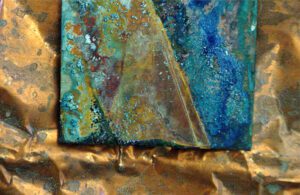 Participants will be housed in the remarkably well-preserved Umbrian hill town of Monte Castello di Vibio. Your workshop package is all-inclusive, providing welcome and departure services and airport transfer from the Rome Fiumicino, Leonardo Da Vinci Airport (FCO). Aboard our comfortable private bus, single occupancy accommodations with shared bath (a wide range of upgrades with private bath are available), 3 meals per day Monday-Thursday, Prosecco brunch and dinner on Saturday and Sunday (no meals are served on Friday, our excursion day. Your workshop includes one excursion per week and many additional options are available on weekends for an additional fee. Of course, 24/7 access to facilities and 24/7 bi-lingual support are provided.
Participants will be housed in the remarkably well-preserved Umbrian hill town of Monte Castello di Vibio. Your workshop package is all-inclusive, providing welcome and departure services and airport transfer from the Rome Fiumicino, Leonardo Da Vinci Airport (FCO). Aboard our comfortable private bus, single occupancy accommodations with shared bath (a wide range of upgrades with private bath are available), 3 meals per day Monday-Thursday, Prosecco brunch and dinner on Saturday and Sunday (no meals are served on Friday, our excursion day. Your workshop includes one excursion per week and many additional options are available on weekends for an additional fee. Of course, 24/7 access to facilities and 24/7 bi-lingual support are provided.
All materials for the class and the excursion are included in the cost of the workshop.
The study of human anatomy in Italy is a long and distinguished tradition. The extraordinary anatomical theatres in medical schools at the University of Padua and the University of Bologna bear witness to this history and were among the first of their kind in existence. Even today, we marvel at the accuracy and lifelike intensity of the 17 th c. wax anatomical models in the Specola Museum in Florence, which were made to allow medical students to observe venous, muscular, and skeletal systems without a cadaver. In this regard, the study of anatomy in Italy has profoundly impacted not only our understanding of the human body, but also the study of medicine in the western world.
Surprisingly, this history also reveals much about the significance of the role of visual art in furthering science and medicine. In his brilliant series of lectures at the Art Students League in New York, artist, anatomist, and scholar, Robert Beverly Hale once said: “science had actually sprung from art, that it had developed in those great periods when artists had looked at nature very closely and carefully, and had tried to record exactly what they saw. That, what we explained, was what scientists have been doing ever since.”
To support Hale’s observation one need look no further than Leonardo’s anatomical studies. These drawings are incredible not only for their accuracy and beauty as works of art, but also as a highly accurate analysis of function, of what anatomist George Bridgeman referred to as “the human machine.” Leonardo is perhaps unequalled in his analysis of the form of the human body as a manifestation of the interrelationship of functioning systems. It is known, for example that Leonardo once injected the heart of an ox with hot wax, then made a glass model of the casting. He then pumped the model with water to analyze the circulation of fluids in the human heart. Incredibly, Leonardo’s conclusions were not fully corroborated by cardiologists until the 1980’s.
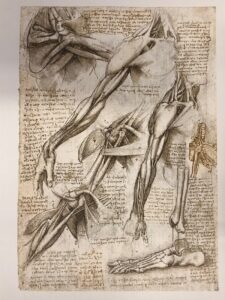 The objective of our Human Anatomy intensive is to follow in this tradition. Thus, we will not only identify anatomical structures of the human body, but we will also analyze the function of those structures and their effect on its outward form. Throughout the workshop, we will reference functional systems in understanding their manifestation in surface anatomy of the figure.
The objective of our Human Anatomy intensive is to follow in this tradition. Thus, we will not only identify anatomical structures of the human body, but we will also analyze the function of those structures and their effect on its outward form. Throughout the workshop, we will reference functional systems in understanding their manifestation in surface anatomy of the figure.
Our focus will be on the skeletal and muscular systems, with some analysis of the major arteries of the venous system. We will work from a variety of sources, including real human skeletons as well as drawing from our collection of anatomical models and plaster casts. Our medium in the course will be various drawing media in large-format sketchbooks as a means of note taking for the course.
Our approach will be in the form of lectures and hands on drawing focusing first on the skeletal system. We will draw from real human skeletons as well as anatomical models. We will explore one area of the body at a time, first in analyzing the skeletal structure of the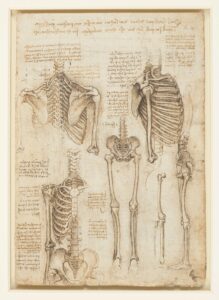 torso. Afterward, we will move on to the head, arms, and legs, as well as hands, and feet. Participants will produce life-sized drawings with charcoal on heavy paper as well as drawings in sketchbooks of details such as joint articulations.
torso. Afterward, we will move on to the head, arms, and legs, as well as hands, and feet. Participants will produce life-sized drawings with charcoal on heavy paper as well as drawings in sketchbooks of details such as joint articulations.
Afterward, the course will focus on the muscular system first through lecture and note-taking then by drawing from anatomical models, plaster casts, and the live model, in the same order. However, we will in exploring the muscular system we will utilize tracing paper and colored pencil, in order to add layers of muscles over our previous skeletal drawings.
In addition to the intensive schedule of daily drawing and lecture, we will make an excursion to the famed Specola Museum in Florence where we will draw from their collection of 16 th to 18th c. wax anatomical sculptures. The incredibly lifelike flayed figures are shockingly lifelike - at once factual and at the same time, powerfully expressive. Here, the wax models will provide an overview of the skeletal and muscular systems as well as an introduction to the venous system.
Throughout the workshop, participants will be housed in the remarkably well-preserved Umbrian hill town of Monte Castello di Vibio. Your workshop package is all-inclusive, providing welcome and departure services and airport transfer from the Rome Fiumicino, Leonardo Da Vinci Airport (FCO). Aboard our comfortable private bus, single occupancy accommodations with shared bath (a wide range of upgrades with private bath are available), 3 meals per day Monday-Thursday, Prosecco brunch and dinner on Saturday and Sunday (no meals are served on Friday, our excursion day. Your workshop includes one excursion per week and many additional options are available on weekends for an additional fee. Of course, 24/7 access to facilities and 24/7 bi-lingual support are provided.
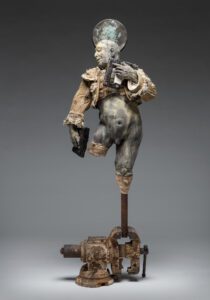 The class will focus on what are perhaps the two most expressive parts of the body: the head and hand. In this two-week workshop, students will learn various techniques to create a series of life-sized bust and hands. Both hollow and solid construction methods will be taught as we work from a live model. Participants will gain understanding of the underling anatomical structures that allow these body parts to be so communicative while learning new techniques to achieve life-like sculptures with clay.
The class will focus on what are perhaps the two most expressive parts of the body: the head and hand. In this two-week workshop, students will learn various techniques to create a series of life-sized bust and hands. Both hollow and solid construction methods will be taught as we work from a live model. Participants will gain understanding of the underling anatomical structures that allow these body parts to be so communicative while learning new techniques to achieve life-like sculptures with clay.
With this objective in mind, it is appropriate that the class should take place in one of the great centers of world sculpture! Indeed, through drawing sessions at the Medici Chapel and Academia Museum in Florence and the Vatican Museum in Rome, students will have the direct influence of the masters!
The class will start with a clay skull and add layers of muscle, culminating in a solid finished bust that will be hollowed out. This will allow us to learn about each muscle and its function in creating expression. Various techniques to hair, eyes, and ears will be covered, as well how to utilize the rules for proportion in your own work.
Students will also learn my hollow construction method used for creating instinctive, fast, and stable forms. Numerous presentations, discussions, and demonstrations will cover topics such as: conceptual considerations, how to measure models for reference work, professional development, impactful contemporary figurative artist, portfolio strategies, and any other topics that students might be interested in. Students will have an opportunity to exhibit their work at the end of the workshop. Open to all skill levels.
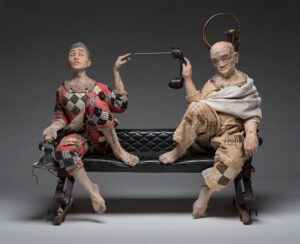 Participants will be housed in the remarkably well-preserved Umbrian hill town of Monte Castello di Vibio. Your workshop package is all-inclusive, providing welcome and departure services and airport transfer from the Rome Fiumicino, Leonardo Da Vinci Airport (FCO). Aboard our comfortable private bus, single occupancy accommodations with shared bath (a wide range of upgrades with private bath are available), 3 meals per day Monday-Thursday, Prosecco brunch and dinner on Saturday and Sunday (no meals are served on Friday, our excursion day. Your workshop includes one excursion per week and many additional options are available on weekends for an additional fee. Of course, 24/7 access to facilities and 24/7 bi-lingual support are provided.
Participants will be housed in the remarkably well-preserved Umbrian hill town of Monte Castello di Vibio. Your workshop package is all-inclusive, providing welcome and departure services and airport transfer from the Rome Fiumicino, Leonardo Da Vinci Airport (FCO). Aboard our comfortable private bus, single occupancy accommodations with shared bath (a wide range of upgrades with private bath are available), 3 meals per day Monday-Thursday, Prosecco brunch and dinner on Saturday and Sunday (no meals are served on Friday, our excursion day. Your workshop includes one excursion per week and many additional options are available on weekends for an additional fee. Of course, 24/7 access to facilities and 24/7 bi-lingual support are provided.
Materials to bring from home:
Xiem, clay tools recommended, Towel, wire tool, paddle (or flat wood), Water spray bottle, small mirror, fabric tape measure
This two-week workshop is divided between two interrelated disciplines: papermaking and printmaking.
In the first week, renowned Italian American paper artist and educator, Roberto Mannino, will introduce the basics of hand papermaking.
In the first week, participants will learn how to create unique papers from virgin, high quality fibers like cotton, linen, and abaca. Color laminations, transparencies and pulp painting effects will support your creativity in composing sheets up to A3 size. Since these papers will be internally sized, they will be rewetted to better retain inks and embossing under the etching press.
In the second week, several alternative printmaking methods will be introduced, with the central focus of first developing imagery with paper as the substrate, then further printing over it:
Two single-day excursions through the amazing countryside of Central Italy will enrich this experience:
In week-one, we will visit the city of Fabriano. In the medieval city, we will visit the Fabriano Paper and Watermark Museum, which houses a working medieval papermaking press. We will also visit the nearby Civic Art Collection, Bruno Molajoli, and the Istocarta, with the impressive Fedrigoni Paper arkive hosted in the Historical Milani Papermill.
In week-two, we will visit Perugia to visit an important collection of medieval manuscripts at the Bibilioteca Augusta and then we will visit the extraordinary, National Museum of Umbria, for a tour of the collections.
Participants in the program will be housed in the remarkably well-preserved Umbrian hill town of Monte Castello di Vibio. Your workshop package is all-inclusive, providing welcome and departure services and airport transfer from the Rome Fiumicino, Leonardo Da Vinci Airport (FCO). Aboard our comfortable private bus, single occupancy accommodations with shared bath (a wide range of upgrades with private bath are available), 3 meals per day Monday-Thursday, Prosecco brunch and dinner on Saturday and Sunday (no meals are served on Friday, our excursion day. Your workshop includes one excursion per week and many additional options are available on weekends for an additional fee. Of course, 24/7 access to facilities and 24/7 bi-lingual support are provided.
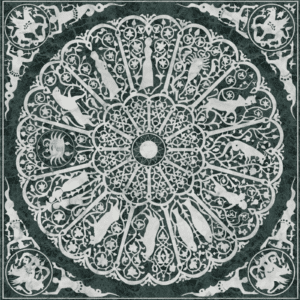 Imagine a week in which you are able to totally absorb yourself in workshop activities, away from the stresses of your daily lives and the pressures of the modern world. Consider an opportunity to dive into yourself and become present, focusing on expression and creativity. There is perhaps no place better for this than our little mountain village overlooking the Tiber Valley in the region of Umbria – known to Italians as “the green heart of Italy.” Here you will explore the body and mind through Yoga, painting, and drawing in a series of experimental workshops.
Imagine a week in which you are able to totally absorb yourself in workshop activities, away from the stresses of your daily lives and the pressures of the modern world. Consider an opportunity to dive into yourself and become present, focusing on expression and creativity. There is perhaps no place better for this than our little mountain village overlooking the Tiber Valley in the region of Umbria – known to Italians as “the green heart of Italy.” Here you will explore the body and mind through Yoga, painting, and drawing in a series of experimental workshops.
Basic Hatha yoga practice will allow participants to slow down, tune into oneself and ones breathing and let the body guide you through simple movements such as Surya Namaskar. Through meditation we will seek to find thoughtless awareness. Through drawing exercises such as mindful observation, we will use our senses to raise awareness and explore imagination through taste, touch and sound.
Students will aim to create a harmonious balance from a mix of structure and improvisation working on heavy grade watercolor paper. Using ink and watercolor, students will create non- objective drawings and paintings. We will be using a variety of techniques gained from studies in both European and Indian processes. We will grind pigments in binders, creating luscious water- based paints of exceptional richness and depth of color. We will prepare paper, underpaint with grids filled with basic algorithms of color over painted and layered with shapes and forms which are sanded, burnished, washed, reworked and detailed to give a final result. The objective is a wholistic approach that considers all elements as meaningful.
As an integral capstone to the experience, we will visit the beautiful city of Florence, where we will research historic designs found in art and architecture. In this, we will take a somewhat different perspective from that of art historical tours. Guided by Emma's background in anthropology we will explore new opportunities provided our own creative work. We will seek to expand our awareness of the mysterious world that the ageless city presents, as well as opportunities that typically unobserved objects and landscapes present.
Participants will be housed in the remarkably well-preserved Umbrian hill town of Monte Castello di Vibio. Your workshop package is all-inclusive, providing welcome and departure services and airport transfer from the Rome Fiumicino, Leonardo Da Vinci Airport (FCO). Aboard our comfortable private bus, single occupancy accommodations with shared bath (a wide range of upgrades with private bath are available), 3 meals per day Monday-Thursday, Prosecco brunch and dinner on Saturday and Sunday (no meals are served on Friday, our excursion day. Your workshop includes one excursion per week and many additional options are available on weekends for an additional fee. Of course, 24/7 access to facilities and 24/7 bi-lingual support are provided.
Menrva, the Etruscan goddess of creativity, was also known as the ‘Goddess of a Thousand Works” – an aspirational goal for writers and academics if there ever was one. There is no better place, then, to channel the spirit of Menrva and focus on your writing than in Umbria, the heart of Etruria, the land of the Etruscans, and the Green Heart of Italy!
The Second Annual Menrva Writing Retreat at the International Center for the Arts in Monte Castello di Vibio provides a week of glorious time and space to write, while also enjoying the beauty of Umbria, the hospitality of an Italian hill town, great conversation, and delicious food and wine!
Open to writers of all kinds, the Menrva retreat will offer the opportunity to engage with yourwork in a supportive community of writers and artists in a beautiful medieval hill town. Communal and individual writing spaces will be available to participants, and daily group writing sessions using a modified Pomodoro Writing Technique (45 minutes of writing followed by a 15-minute break) will be offered. Days are largely unstructured, save for the delicious meals, and opportunities for group discussion and presentation of your work are available for those who wish to do so.
Participants will be housed in the remarkably well-preserved Umbrian hill town of Monte Castello di Vibio. Your workshop package is all-inclusive, providing welcome and departure services and airport transfer from the Rome Fiumicino, Leonardo Da Vinci Airport (FCO). Aboard our comfortable private bus, single occupancy accommodations with shared bath (a wide range of upgrades with private bath are available), 3 meals per day Monday-Thursday, Prosecco brunch and dinner on Saturday and Sunday (no meals are served on Friday, our excursion day. Your workshop includes one excursion per week and many additional options are available on weekends for an additional fee. Of course, 24/7 access to facilities and 24/7 bi-lingual support are provided.
For academics, a letter of invitation which you can present to your university or institution, can be provided, if needed.
Please contact Dana Zartner at dana.zartner@gmail.com with any questions.